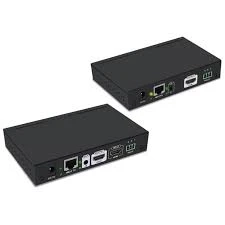HDMI stands for High Definition Multimedia Interface from a technological perspective. This worldwide networking standard gets designed to have high-definition video and audio transmission on various devices. The purpose of HDMI is to improve the quality of audio and video systems.
You may enjoy all-digital solutions you use to connect and interconnect with other parts of your home or business system with only one HDMI connection. Thanks to this improved technology, your systems can connect with one other and share critical data. This makes it possible for modifications and optimization to be done automatically in a simple and cost-free way.
What is HDMI Over Ethernet?
A single input signal gets accepted by AV devices like extenders, switches, or matrices that distribute the same signal to several isolated outputs and destinations without ground loops or signal degradation to accomplish HDMI distribution. Multiple amplification, cable television, dividing monitor and front-of-house mixes, and "tapping" a signal before it goes through effects units to retain a "dry" signal for later experimentation are just a few of the frequent technical jobs they get employed for.
To network with other IP-based devices, routers, and modems that provide Internet access, many home entertainment gadgets feature a dedicated connection for connecting stand-alone Ethernet cables. One HDMI cable now carries data streams previously handled by separate Ethernet connections.
Cable consolidation is the HDMI Ethernet Channel\'s main advantage. Home theater customers must rely on one Ethernet wire linked to a television or receiver instead of numerous cords. Then, you can make data transfers from a primary source to additional IP-based home entertainment devices via HDMI connections with Ethernet capabilities. This configuration is enjoyable for users.
What are the Benefits of HDMI Over Ethernet?
HDMI over Ethernet is a great way to connect your home theater system to the Internet, but you can also use it to extend your existing home network.
The most significant benefit is that it directly connects the source device and your receiver or display. This means you don\'t have to go through the cable box or other components in the middle and can plug directly into the HDMI input on your device. This also means that if you have multiple devices connected to your router, they will all use their separate ports, which can be problematic if they are in different rooms or not close enough.
Another benefit is that it allows for a higher quality signal than standard composite video signals. With standard composite cables, there are typically two types of signals involved: audio and video. For these two signals to work together correctly, you must send them through different channels on the same cable.
How does HDMI Over Ethernet work?
It is a way to use the HDMI standard to connect computers and other devices to high-definition displays. It differs from traditional HDMI because it uses Ethernet instead of Blu-ray or other protocols.
The main advantage of using this technology is that it allows you to bypass the cable, which means you can use any device without worrying about compatibility issues. You can also use an Ethernet cable, including wireless ones. Since no wires are involved, there are no restrictions on how many devices can be connected simultaneously.
Ending Note
Using HDMI over Ethernet has several advantages over using traditional HDMI cables. Standard cables require a source device (computer) and target device (display). With this technology, you only need one device — the display itself — and any other device that supports HDMI over Ethernet.



